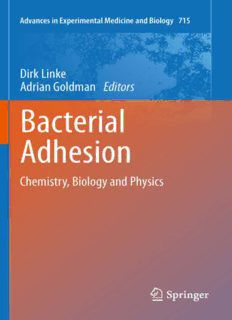
Bacterial Adhesion: Chemistry, Biology and Physics PDF
Preview Bacterial Adhesion: Chemistry, Biology and Physics
Bacterial Adhesion ADVANCESINEXPERIMENTALMEDICINEANDBIOLOGY EditorialBoard: IRUNR.COHEN,TheWeizmannInstituteofScience ABELLAJTHA,N.S.KlineInstituteforPsychiatricResearch JOHND.LAMBRIS,UniversityofPennsylvania RODOLFOPAOLETTI,UniversityofMilan Forfurthervolumes: http://www.springer.com/series/5584 · Dirk Linke Adrian Goldman Editors Bacterial Adhesion Chemistry, Biology and Physics 123 Editors DirkLinke AdrianGoldman MaxPlanckInstitute UniversityofHelsinki forDevelopmentalBiology InstituteofBiotechnology DepartmentofProteinEvolution Viikinkaari1 Spemannstr.35 FIN-00014Helsinki 72076Tübingen Finland Germany adrian.goldman@helsinki.fi [email protected] ISSN0065-2598 ISBN978-94-007-0939-3 e-ISBN978-94-007-0940-9 DOI10.1007/978-94-007-0940-9 SpringerDordrechtHeidelbergLondonNewYork LibraryofCongressControlNumber:2011924005 ©SpringerScience+BusinessMediaB.V.2011 Nopartofthisworkmaybereproduced,storedinaretrievalsystem,ortransmittedinanyformorby anymeans,electronic,mechanical,photocopying,microfilming,recordingorotherwise,withoutwritten permissionfromthePublisher,withtheexceptionofanymaterialsuppliedspecificallyforthepurpose ofbeingenteredandexecutedonacomputersystem,forexclusiveusebythepurchaserofthework. Printedonacid-freepaper SpringerispartofSpringerScience+BusinessMedia(www.springer.com) Introduction Why a book on bacterial adhesion? Adhesion plays a major role in the bac- terial lifestyle. Bacteria adhere to all surfaces and did so long before the first eukaryotes were around; stromatolites, which are calcium-based rocks in shallow seawaters formed and inhabited by cyanobacteria, are among the oldest fossils found (Battistuzzi et al., 2004). Bacteria can adhere to each other, a phenomenon referredtoasautoagglutination,whichisgenerallyviewedasoneofthefirststeps towardsbiofilmformation.Bacteriacanalsoformmorecomplexanddefinedstruc- tures,suchastheMyxococcusfruitingbodies–Myxococcusisgenerallyseenasa “social”bacteriumwithcomplexinter-cellinteractions,andasamodelfortheearly evolution of multicellularity (Konovalova et al., 2010). Last but not least, bacteria can adhere to other cells: different prokaryotic species in the formation of com- plex biofilms, or eukaryotic cells during disease. Adhesion to eukaryotic cells can serve different purposes in commensalism, symbiosis, and pathogenesis. The gen- eralprinciple,theexpressionofsurfacemoleculestoadheretootherstructures,stays thesame. But why this particular book when reviews on bacterial pathogenesis are com- mon,ifnotquiteadimeadozen?Ourfocusis:howaresuchadhesionphenomena best studied? Microbial genetics experiments have greatly enhanced our knowl- edge of what bacterial factors are involved in adhesion. For numerous reasons, though,biochemicalandstructuralbiologyknowledgeofthemolecularinteractions involved in adhesion is limited. Moreover, many of the most powerful biophysi- cal methods available are not frequently used in adhesion research, meaning that the time dimension – the evolution of adhesion during biofilm formation remains poorlyexplored.Thereasonforthisis,webelieve,ontheonehandmicrobiologists, who are experts at handling and manipulating the frequently pathogenic bacterial organisms in which adhesion is studied, lack detailed knowledge of the biophysi- calpossibilitiesandhavelimitedaccesstothefrequentlyexpensiveinstrumentation involved. On the other hand, the experts in these methods frequently do not have accesstothebiologicalmaterials,nordotheynecessarilyunderstandthebiological questionstobeanswered.Thepurposeofthisbookisthustoovercomethisgapin communication between researchers in biology, chemistry, and physics, and to displaythemanywaysandmeanstoaddressthetopicofbacterialadhesion. v vi Introduction Thus,thebookconsistsofthreelooselyconnectedparts.ThefirstChapters1to7 deal, broadly speaking, with bacterial adhesion from a biological perspective, where different bacterial species and their repertoire of adhesion molecules are described. The chemistry section includes the biochemistry and structural biol- ogy knowledge which have been obtained on some of the adhesin systems. The physicssectioncontainsexamplesofbiophysicalmethodsthathavebeensuccess- fully applied to bacterial adhesion. For obvious reasons, we had to limitourselves in the choice of systems and methods described in this book. The biological systems described are only examples, and mostly come from genera containing the better-studied human pathogens. We tried nonetheless to cover a broad spec- trum of organisms, both Gram-positive and Gram-negative bacteria. Chapters 1 and 9 also put specific Gram-negative and Gram-positive systems into a historical perspectiveanddescribethedevelopmentofthefieldofinfectiousdiseases.Many of the findings also apply to bacteria that are either non-pathogenic (Chapter 13) orpathogenic ondifferentspeciesandkingdoms,and Chapter 5nicelyshowsthat in plant pathogens, adhesins similar to those of human pathogens exist and serve comparablefunctions. Thechemistrysection(Chapters8to15),containsexamplesofmolecularstruc- turesoftheverydifferenttypesofadhesinsfound.Thesearemostlyfromthehuman pathogens discussed in the biology section, again from both Gram-negative and Gram-positivebacteria.Wehavealsoincludedtwochaptersoncarbohydratestruc- tures (13 and 14), as these structures are at least as important as the proteins in bacterialpathogenesis.Onepatternthatemergesisthatmostoftheseadhesinscon- tain repetitive elements, which make them long and fibrous, but which might also allow for easy recombination and thus evolution in the face of the host immune system. The physics section (Chapters 16 to 22) originally seemed the hardest to fill: howshouldweidentifymethodsusefulinadhesionresearch,butinfrequentlyused? Discussionswithcolleaguesandliteraturesearchesledustoauthorsonsuchdiverse methods as force measurements, electron microscopy, NMR, and optical tweez- ers, as well as a chapter on how bacteria adhere to medical devices and how this can be studied (Chapter 22). Moreover, the enthusiastic response of these authors showedtousthatindeed,thereisaneedforaforumtodisplaythepaneloftechnical possibilitiestotheresearcherswhostrugglewithunsolvedbiologicalquestions. Nowthatthebookisfinishedandoutofourhands,wehopethatitwillachieve our goals – that it will be of broad interest to researchers from different fields all workingondifferentaspectsofbacterialadhesion.Wehopeitprovidesanadvanced but jargon-free introduction to the state of adhesion research in 2010, one that will bring researchers together in new, exciting, and most importantly, interdisci- plinary projects. The struggle for new therapies against bacterial infections is not made easier by the “Red Queen Principle” – the fact that pathogens evolve and adaptquicklyinthefaceofnewchallenges(vanValen,1973).Westronglybelieve that only interdisciplinary research can tackle the growing problems of multidrug Introduction vii resistance, hospital-acquired infections, and other adhesion- and biofilm-related topicsinhumanhealththatrequirenewdrugs,disinfectants,orvaccines. WethankallofourauthorsfortheirhardworkandThijsvanVlijmenofSpringer forbeingalwaysavailabletoanswerourquestions. Tübingen DirkLinke Helsinki AdrianGoldman November2010 References BattistuzziFU,FeijaoA,HedgesSB(2004)Agenomictimescaleofprokaryoteevolution:insights intotheoriginofmethanogenesis,phototrophy,andthecolonizationofland.BMCEvolBiol4 Konovalova A, Petters T, Sogaard-Andersen L (2010) Extracellular biology of Myxococcus xanthus.FEMSMicrobiolRev34:89–106 vanValenL(1973)Anewevolutionarylaw.EvolTheory1:1–30 ThisisBlankPageIntegra viii Contents 1 AdhesinsofHumanPathogensfromtheGenusYersinia . . . . . . 1 JackC.LeoandMikaelSkurnik 2 AdhesiveMechanismsofSalmonellaenterica . . . . . . . . . . . . 17 CarolinWagnerandMichaelHensel 3 AdhesionMechanismsofBorreliaburgdorferi . . . . . . . . . . . . 35 StylianiAntonara,LauraRistow,andJeniferCoburn 4 AdhesinsofBartonellaspp. . . . . . . . . . . . . . . . . . . . . . . 51 FionaO’Rourke,ThomasSchmidgen,PatrickO.Kaiser, DirkLinke,andVolkhardA.J.Kempf 5 AdhesionMechanismsofPlant-PathogenicXanthomonadaceae . . 71 NadiaMhedbi-Hajri,Marie-AgnèsJacques,andRalfKoebnik 6 AdhesionbyPathogenicCorynebacteria . . . . . . . . . . . . . . . 91 ElizabethA.Rogers,AsisDas,andHungTon-That 7 AdhesionMechanismsofStaphylococci . . . . . . . . . . . . . . . 105 ChristineHeilmann 8 Protein Folding in Bacterial Adhesion: Secretion andFoldingofClassicalMonomericAutotransporters . . . . . . . 125 PetervanUlsen 9 StructureandBiologyofTrimericAutotransporterAdhesins . . . 143 AndrzejŁyskowski,JackC.Leo,andAdrianGoldman 10 Crystallography and Electron Microscopy ofChaperone/UsherPilusSystems . . . . . . . . . . . . . . . . . . 159 SebastianGeibelandGabrielWaksman 11 CrystallographyofGram-PositiveBacterialAdhesins . . . . . . . 175 VengadesanKrishnanandSthanamV.L.Narayana ix
Description: